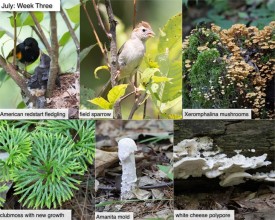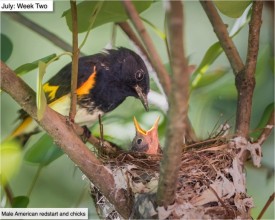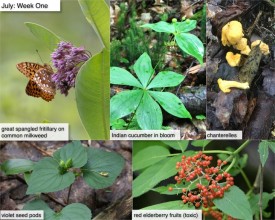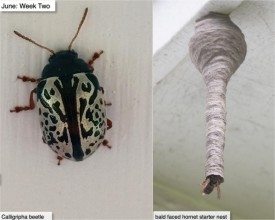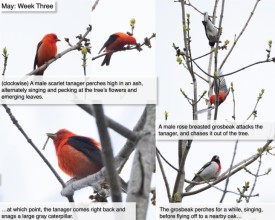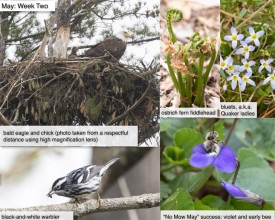This Week in the Woods, as we move into late summer, there’s a lot less singing in the woods but we’re still hearing hermit thrushes, red-eyed vireos, and winter wrens. We’re…
This Week in the Woods
July: Week Five
This week in the woods, we’ve been seeing a lot of Monotropa in bloom – both ghost pipe and pinesap, shown here in the company of a bumble bee. Neither of these plants…
July: Week Four
This week in the woods, we’ve been seeing northern pearly-eyes fluttering up from the ferns along long woods trails. These forest butterflies – beautifully marked with black spots…
July: Week Three
This Week in the Woods, the American redstart chicks we featured last week have all successfully fledged. Here’s the last fledgling to go, a few minutes before the young bird hopped out…
July: Week Two
This week in the woods, we didn’t have to venture far for a great nature photography opportunity. We found an American redstart nest in a stand of yard lilacs and set up a remote (no…
July: Week One
This week in the woods, we’ve reached summer’s second act. Spring blooming plants are producing seeds and fruits, and suddenly, butterflies seem to be everywhere. Monarchs…
June: Week Four
This week in the woods, the torrential rains over the past few days have been a hardship for nesting birds, threatening both ground nests and, to a lesser degree, nests in trees. We found…
June: Week Three
This week in the woods, we found a family of fish crows rummaging in the vegetation along a river bank. Fish crows are slightly smaller than American crows but otherwise very difficult to…
June: Week Two
This week in the woods, we enjoyed our office backyard “moth ball” with lepidopterist JoAnne Russo, who identified a whopping 86 different moth species flitting through the night…
June: Week One
This week in the woods, we discovered a wild turkey egg tucked within a decaying tree stump and partly covered with moss and wood. To figure out what had happened, we checked with Northern…
May: Week Five
This Week in the Woods, there are several showy wildflowers coming in bloom, including lady’s slippers, columbine, rhodora, and painted trillium. Meghan McCarthy McPhaul took this…
May: Week Four
This Week in the Woods, we’re continuing last week’s theme of high bird drama with two images (courtesy of Tig Tillinghast) of a male red-winged blackbird attacking a crow. Moments…
May: Week Three
This week in the woods, the summer canopy is rapidly closing, which means that the window of opportunity to easily observe summer forest birds is closing, too. Scarlet tanagers are especially…
May: Week Two
This Week in the Woods, bald eagle chicks are growing quickly, and by this point, many have shed their white baby fuzz. The eaglet in this nest (photographed with a high magnification lens…
May: Week One
This Week in the Woods, hermit thrushes are back and flitting around in pairs, with stops along the way to rummage in leaf litter for tasty invertebrates. One of the key identifying traits of…
April: Week Four
This week in the woods, one of our most exquisite spring ephemeral wildflowers is starting to bloom. Bloodroot — a member of the poppy family that gets its name from the red juice in its…
April: Week Three
Most weeks, this blog covers relatively easy-to-see species. This week, we’re making an exception, for a happy reason: this past week, a team of volunteers documented four-toed…
April: Week Two
This week in the woods, one of our most exciting finds was, by design, not very exciting to look at. This is a well-hidden active barred owl nest, a status we realized a few seconds after…
April: Week One
This week in the woods, we’re at a seasonal tipping point, when there’s still snow blanketing many areas, but on sunny, south-facing slopes, the first wildflowers are blooming. We…
March: Week Four
This week in the woods, we’re sharing a mostly-bird themed post, along with a timely PSA that despite the snowy conditions, bears are waking up. Wildlife biologists recommend bringing in…





